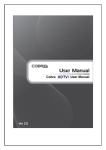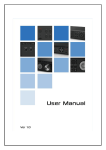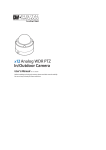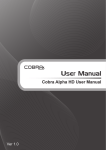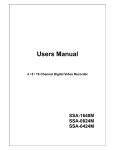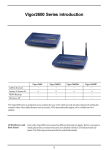Download Digital Watchdog DWC-PTZ10x Specifications
Transcript
G GGGGGGGGGGGGGGGGGGGGGGGGGGGGGGGG PRECAUTIONS Warning Unauthorized reproduction of all or part of this manual is strictly prohibited. The FIGURES in this manual are only for illustration purposes. They may differ from the actual product. The specifications and design of the product are subject to change without prior notice for purposes of quality improvement. Cautions To get the best use out of the product, be sure to read the cautions before using the product. For safety, please take note of the following: Instructions Before Using the Product To prevent electric shock when installing, moving, or opening the DVR and peripheral devices, connect and disconnect the cables as instructed. All cables must be connected to grounded power outlets. If the product is installed near a power outlet, make sure it can easily be unplugged. Do not use the DVR in water or in wet places. Keep the plastic packing materials used for the DVR or other peripheral devices out of reach of children (may cause suffocation). Installation Environment of the DVR Maintain the following conditions: operating temperature of 5˚C ~ 40˚C, operating humidity of 10% ~ 80%. Install the DVR in a safe place that is free from external vibration. Install the DVR in a well-ventilated place. To protect the hard disk from data loss and breakdown, install the DVR away from magnetic materials. When using a rack other than the standard one, use a separate table with sufficient spacing, i.e., 60cm from the floor, 50cm from the ceiling, and 20cm from the side and back walls and other objects. Safety Notes on the DVR When installing additional boards and HDD, separate the power cable and completely turn off the power supplied to the DVR. Keep the product away from heat-generating devices, such as heaters. Do not use a damaged power cord. To prevent problems due to magnetic interference and electric surge, use only grounded cables and power outlets. If the power cord is connected, do not touch the power unit. If the power cord is connected, electric current is still flowing internally even after the switch is turned OFF. Do not place a heavy object on top of the product. Do not drop a conductive object in the ventilation holes. Allot sufficient space for system cabling. Use only the parts indicated in the manual. Do not disassemble, repair, or modify the product without permission. Incorrect system setup may cause malfunction. Shut down the system normally as instructed in the manual. Safety Notes on the Lithium Battery Replace lithium batteries as instructed to avoid danger. Dispose used lithium batteries properly. Warning and Caution are indicated as follows. Possible Injury or Product Damage Risk of Minor Injury or Product Damage Cautions for the Usage of the Product Information for the Usage of the Product 2 GGGGGGGGGGGGGGGGGGGGGGGGGGGGGGGG TABLE OF CONTENTS 1 INTRODUCTION .......................................................................5 Specifications .................................................................................................................................................. 5 Components .................................................................................................................................................... 5 Major Features ................................................................................................................................................. 6 Front Panel View ............................................................................................................................................. 7 Rear Panel View ............................................................................................................................................... 7 2 INSTALLATION & CONNECTION .............................................8 Connection Order ............................................................................................................................................ 8 Terminal Block ................................................................................................................................................. 9 PTZ Camera & Keyboard Controller .............................................................................................................. 9 Sensor Connection ......................................................................................................................................... 9 Relay Connection ............................................................................................................................................ 9 POS Connection .............................................................................................................................................. 9 3 SYSTEM CONTROL ............................................................... 10 Remote Controller ......................................................................................................................................... 10 Mouse ............................................................................................................................................................. 10 Power ON ....................................................................................................................................................... 10 4 SETUP ................................................................................... 11 Time ................................................................................................................................................................ 12 Camera ........................................................................................................................................................... 14 Recording ....................................................................................................................................................... 20 Schedule ........................................................................................................................................................ 25 Disk Configuration ........................................................................................................................................ 26 Network Configuration .................................................................................................................................. 28 System ............................................................................................................................................................ 33 5 LIVE ....................................................................................... 36 Real-Time Live View ...................................................................................................................................... 36 Status Icons ................................................................................................................................................... 37 Control Bar ..................................................................................................................................................... 37 System Login ................................................................................................................................................. 38 System Logout .............................................................................................................................................. 38 Screen Division and Auto Sequence ........................................................................................................... 39 Zoom............................................................................................................................................................... 40 Instant Recording .......................................................................................................................................... 40 6 SEARCH ................................................................................. 41 Express Search ............................................................................................................................................. 41 Jump to Last Saved Data .............................................................................................................................. 42 Jump to First Saved Data ............................................................................................................................. 42 Go to Last Played Time................................................................................................................................. 42 7 PLAYBACK ............................................................................ 43 Playback Control Bar .................................................................................................................................... 43 Smart Search ................................................................................................................................................. 44 Express Search ............................................................................................................................................. 45 Multi Time....................................................................................................................................................... 45 Multi Day ........................................................................................................................................................ 45 Multi Channel ................................................................................................................................................. 45 Panorama Playback ...................................................................................................................................... 45 Event............................................................................................................................................................... 45 Audio .............................................................................................................................................................. 45 Backup ........................................................................................................................................................... 46 3 GGGGGGGGGGGGGGGGGGGGGGGGGGGGGGGG Zoom............................................................................................................................................................... 46 De-Interlace .................................................................................................................................................... 46 8 BACKUP ................................................................................ 47 Backup ........................................................................................................................................................... 48 Capture ........................................................................................................................................................... 49 Print ................................................................................................................................................................ 49 Log Backup .................................................................................................................................................... 49 Setup Backup ................................................................................................................................................ 50 NAS Backup ................................................................................................................................................... 50 9 PTZ ........................................................................................ 51 Setting a PTZ Camera ................................................................................................................................... 51 Controlling a PTZ Camera ............................................................................................................................ 52 10 SYSTEM INFORMATION ..................................................... 53 Version ........................................................................................................................................................... 53 System Log .................................................................................................................................................... 54 Miscellaneous Control .................................................................................................................................. 55 Monitor Configuration ................................................................................................................................... 56 Channel Grouping ......................................................................................................................................... 56 11 REMOTE ACCESS ................................................................ 57 Features ......................................................................................................................................................... 57 Connection..................................................................................................................................................... 57 Live Mode ....................................................................................................................................................... 58 Playback Mode .............................................................................................................................................. 59 Management .................................................................................................................................................. 59 12 DNA ..................................................................................... 61 Setup .............................................................................................................................................................. 61 User Interface ................................................................................................................................................ 63 Configuration ................................................................................................................................................. 64 Playback ......................................................................................................................................................... 66 Control............................................................................................................................................................ 68 Event............................................................................................................................................................... 69 13 RAID .................................................................................... 70 Configuring RAID .......................................................................................................................................... 70 Destroying RAID ............................................................................................................................................ 71 APPENDIX ................................................................................ 72 Recommended HDD Specification .............................................................................................................. 72 Recommended PTZ Camera Protocol ......................................................................................................... 72 Recommended USB 2.0 Device ................................................................................................................... 72 4 GGGGGGGGGGGGGGGGGGGGGGGGGGGGGGGG 1 INTRODUCTION Specifications VMAXD1 16 VMAXD1 8 Full D1 Digital Video Recorder 16Ch – D1 480/400 8Ch – D1 240/200 Linux Embedded - Built in Flash Memory 16 BNC 8 BNC System Format OS Video Input Video Output Monitor Spot Audio Input Audio Output Compression Format Recording Speed Recording Resolution Recording Mode Alarm Interface Video Output Resolution POS / ATM Interface Backup & Copy Access Network Access PTZ / Controller Access Internal HDD / Internal ODD System Operation & Adjustment System Upgrade Network Others 16 BNC, 1 VGA, 1 HDMI 8 BNC, 1 VGA, 1 HDMI 4 BNC - Single or Quad Line Input : 16 RCA 1 BNC - Single or Quad Line Input : 8 RCA Line Output : 1 RCA Video : Standard H.264 / Audio : G.723 1/8, 1/4, 1 ~ 30(25)fps, Total max. D1 480/240(400/200)fps CIF, 2CIF, 4CIF Continuous, Event (Sensor, Motion, Audio, Pattern, Text), Schedule 16 Sensor Input, NC/NO - Terminal Block 8 Sensor Input, NC/NO - Terminal Block 4 Relay Output, NC/NO - Terminal Block 2 Relay Output, NC/NO - Terminal Block HDMI : Full HD(1920x1080), WSXGA+(1680x1050), SXGA(1280x1024) VGA : WSXGA+(1680x1050), SXGA(1280x1024) BNC: SDTV(720x480(576)) 8 RS232C Simplex - Terminal Block 4 RS232C Simplex - Terminal Block eSATA, DVD-RW, USB2.0, Network Ethernet 10/100/1000 - RJ45 RS485 Half Duplex - Terminal Block SATA HDD Max. 4ea / SATA Type DVD 1ea(Without ODD, HDD 6ea) Front Panel Button, Mouse, IR Remote Control, Keyboard Controller, Network USB2.0 Memory Stick, Network System Automation (Controlled by CMS) NTP Supported CMS / Monitoring by Web Browser / PDA 17 Languages Supported, Automatic E-mail DC12V, 5A / Operating Temperature [5 ~ 40] Weight without HDD [8kg] / Dimension [435 x 4445 x 88 mm] Components After unpacking the product, check whether the following accessories have been included. . x x x x x Remote Controller Software CD AAA 1.5V Batteries (2 Each) Quick Start Guide Handle 5 GGGGGGGGGGGGGGGGGGGGGGGGGGGGGGGG Major Features Advanced H.264 Linux Embedded DVR HEXAPLEX – Live, Playback, Recording, Backup, Network, Configuration Full HD Output for Playback and Live Display 240fps at D1 for 8 Channel 480fps at D1 for 16 Channel HDMI, Composite, & VGA Support Jog Shuffle Looping Output Zoom-in Live and Playback Multi-Record Scheduling Pre- & Post-Event Recording Programmable Privacy Zones 8 Sensor Input, 2 Sensor Output for 8 Channel 16 Sensor Input, 4 Sensor Output for 16 Channel Time Server Function NAS (Network Attached Storage) Backup Over Ethernet Multi-User Access Covert Channel Network Bandwidth Control Watermark Verification (Digital Signature Verification) Go To, Multi-Date & Time, Calendar, Smart, Panorama, and Log Viewer Search Smart Web Viewer for Live, Playback, Backup, Configuration Remote Setup, Backup, and Relay Control Mobile Application for Blackberry, iPhone, Android Windows Mobile PDA Viewer RAID 1,5: Rack Mount Available DVD-RW Built-in USB 2.0 Built-in POS Support up to 8 Channel RS-485 and 4/8 RS-232C Built-in USB Mouse, IR Remote Control Up to 6 Internal HDD Supported 6 GGGGGGGGGGGGGGGGGGGGGGGGGGGGGGGG Front Panel View No 1 Name Power Button Description Turn ON or OFF. Authorization is required. 2 Lock Button Lock your system. Authorization is required. 3 Number Buttons Select channel. 4 5 6 Status Indication Optical Device Bay Functional Buttons Directional Button and Select Key Indicates each functional status. Door for CD-ROM Shortcut keys for the indicated function. 7 Use instead of mouse control. Rear Panel View No 1 Name Power Supply 2 Camera Input, Loop Output, Audio Input, Spot Output 3 USB Connection (USB2.0, e-SATA) 4 5 6 7 8 9 Configuration Dip Switch (NTSC/PAL, Monitor Out) RS232C for Console Output Ethernet Port VGA Output HDMI Output for Full HD Display Audio Out, TV Out, Terminal Block (Sensor & Relay Output) 7 GGGGGGGGGGGGGGGGGGGGGGGGGGGGGGGG 2 INSTALLATION & CONNECTION Connection Order By referring to the diagram above [Figure 2-1], make a connection accordingly. ཛ Connect CCTV Camera Signal to BNC Input on rear panel. ཛྷ Set video configuration with combination of dip switch. ཝ Connect display monitor to TV OUT on rear panel. No GUI is displayed through TV Out port. ཞ Connect VGA monitor to VGA OUT on rear panel and HDMI monitor to HDMI on rear panel. On VGA and HDMI Output, only the channel title is shown. For higher resolution (greater than HD), only VGA Output is available. ཟ Connect Spot Monitor to SPOT # on rear panel. འ The following devices can also be connected: Devices Internal Hard Drives Spot Monitor Audio Sensor Relay POS DVR Terminal 6 SATA 4 BNC for 16 Channel 1BNC for 8 Channel Each Channel Each Channel 4 for 16 Channel 2 for 8 Channel 8 Connections for 16 Channel 4 Connections for 8 Channel 8 GGGGGGGGGGGGGGGGGGGGGGGGGGGGGGGG Terminal Block The terminal blocks located in the rear of the VMAXD1 are for the connection of the PTZ, Sensor, Relay, and POS. The number of terminal blocks may vary depending on the model.G G PTZ Camera & Keyboard Controller Connect the PTZ control cable to the Terminal Block, TRXD+ and TRXD-, in the rear panel of the DVR. You may refer to “APPENDIX” in this manual for supported PTZ cameras. A keyboard controller has the same connection as a PTZ camera. Sensor Connection Depending on the model, connect the sensor to the terminal blocks S1 ~ S16. Each input terminal is connected relatively with the channel number. Sensor and Relay Type NC (Normal Close): Normally Closed; opens when a signal is received. NO (Normal Open): Normally Open; closes when a signal is received. Relay Connection Relay the output signal to external devices, such as Alarm and Siren. Connect the relay to R1, R2, R3, or R4 terminal block, depending on the model POS Connection Connect the POS Device. Connect the POS to Terminal Block RXD1 ~ RXD8, depending on the model. Depending on its type, the external alarm device may require a power supply. Please be cautious. 9 GGGGGGGGGGGGGGGGGGGGGGGGGGGGGGGG 3 SYSTEM CONTROL The VMAXD1 series can be controlled easily by using the front panel buttons, front panel jog/shuttle, remote controller, and/or the mouse. Remote Controller No 1 Name Power Button 2 Number Buttons in Input Number 3 DVR ID Button 4 5 6 System Operation and Setup Menu: Enter Menu Esc: Exit to Previous Mode Search: Search Recorded Image Select: Select Category or Execute Sequence Copy: Copy Recorded Videos Direction: Move within the Menu and Submenu Up & Down: Move Up and Down on Log Page PTZ: Shift to PTZ Camera Control Mode Record Button Sensor and Relay Type NC (Normal Close): Normally Closed; opens when a signal is received. NO (Normal Open): Normally Open; closes when a signal is received. Mouse The mouse pointer, as shown below, appears if a mouse is connected to the USB terminal located at the front panel. MOUSE CONTROL FUNCTIONS Click Right Button Monitoring Mode Move from Monitoring Mode to Monitoring Setup Open or Hide Play Menu Show Submenu of the certain Setup window Click Left Button Select Setup Double-Click Right Button Select Setup Double-Click Left Button Move a certain window Power ON ཛ ཛྷ ཝ Check the VMAXD1 Series (100-240V, 50/60Hz) and connect the power. Booting will be initiated by pressing the power button in the front panel. After booting is finished, the Monitoring Screen, Channel Indication, and Clock are all displayed. 10 GGGGGGGGGGGGGGGGGGGGGGGGGGGGGGGG 4 SETUP For Setup menu, click the right button of the mouse or press [Setup] button on the front panel. ID and Password are required for initial installation. Default ID and Password are shown below. Local Admin: 00000, User1 : 1111111, User2 : 2222222, User3 : 333333, User4 : 4444444 To change the password, right click on mouse, and click [Setup] > [System] > [Admin. Password]. 11 GGGGGGGGGGGGGGGGGGGGGGGGGGGGGGGG Time Right-click the mouse button; then select [Setup] > [Time]. Time Sync Synchronize the time with the NTP (Network Time Protocol) server. The time will be synchronized with the NTP once every hour. If synchronization with the NTP server fails, synchronization with RTC will be established. £ Set the Time Sync to NTP or OFF. ¤ ¥ If NTP is selected, input the Server Type and Server URL. For automatic NTP setup, set Server Type to NTP and Server URL as Auto. NTP setup is only available when Time Sync has been set to NTP. The user can enter the IP only when the server type is DVR. Date & Time If Time Sync is set to OFF, set the date and time manually. £ Use the mouse or the arrow keys and the SELECT button to set the Year, Month, Day, Hour, Minute, and Second on Date & Time. ¤ ¥ To complete the setting, click the SELECT button or click the right button on mouse. Select the format you wish to display the date at Date Display Type. Select from DD/MM/YY, MM/DD/YY, and YY/MM/DD Only available when Time Sync is off. 12 GGGGGGGGGGGGGGGGGGGGGGGGGGGGGGGG Time Zone £ ¤ Select your local Time Zone. Turn ON or OFF the daylight savings time (DST). ¥ If DST has been set to ON, select the Start Time and End Time for DST. For a weekly setting in the [Start Time] and [End Time] fields, set Day to 0. After the DST has been selected, the existing data will display as “OLD_” in the search and log list. Auto Reboot To help keep your system healthy, configure your VMAXD1 to reboot automatically. £ Use your mouse to set the Auto Reboot to ON or OFF.. ¤ Select the exact time for Auto Reboot, and select the day of the week you wish to perform Auto Reboot. 13 GGGGGGGGGGGGGGGGGGGGGGGGGGGGGGGG Camera Right-click mouse button; then select [Setup] > [Camera]. Camera To setup a camera, select the Camera tab. Connect: Connect or disconnect the camera channel. ON means cameras is connected. To disconnect, turn camera OFF. When the camera channel is set to disconnected, the video contents will not be displayed even if the camera is actually connected. Name: Name each camera. £ Move mouse cursor above the name field and double click the left mouse button. ¤ Input camera name on input panel. Up to 20 letters are allowed. Covert: Turn ON to hide the camera on the monitoring screen and display a black screen. Although the display screen is black, data is still being recorded and saved, depending on the recording schedule. PZ Mask: Used to hide a certain area of the real-time monitoring screen. £ To setup the PZ Mask Area, move cursor above the PZ Mask field for the channel you wish to set and click the left mouse button. ¤ ¥ The channel will be displayed with grid lines. Select the blocks you wish to mask by clicking and dragging the mouse. Right click mouse button when setup has been completed. Adjust: Select to adjust the camera’s Brightness, Contrast, Color, Saturation, Sharpness, and Camera Position. When clicked, the single channel mode appears with the Adjust window. Excessively moving the camera up, down, right, or left may cause black or gray areas to appear on the display screen. The level at which such condition does not occur is based on the proper control range for the camera. 14 GGGGGGGGGGGGGGGGGGGGGGGGGGGGGGGG PTZ To setup a PTZ camera, select the PTZ tab. £ Select the Protocol for the PTZ camera you are using. ¤ ¥ Setup Camera ID and Baud Rate. Check your camera manual for the information. Set a Tour, so camera can automatically move between different presets. Configure up to two Tours, and each tour can have up to 8 presets ¦ If a tour has been set, set the Duration for the staying time when the tour is activated. POS To setup a Point-of-Sale (POS) device, connect the POS device to the Terminal Block connection for RS232C. Go to [Setup] > [System] > [Sensor/POS Port], and select POS (1-8). Go to [Setup] > [Camera] > [POS], and select the protocol, baud rate, and character code for your POS device. The VMAXD1 only indicates ASCII Characters. 15 GGGGGGGGGGGGGGGGGGGGGGGGGGGGGGGG When the POS device has been configured, setup the VMAXD1 to record any transactions sent from the POS device. Go to [Setup] > [Recording] > [Recording], and make sure Text is set to ON. 16 GGGGGGGGGGGGGGGGGGGGGGGGGGGGGGGG User can perform a search by looking up an item on the POS transaction. ཛ To perform a search based on POS transactions, click the right mouse button during Playback Mode, and click [Text Search] > [CH##]. ཛྷ A Keyboard will appear. Using the mouse, type in the item you wish to search; then click Search button. The keyboard is case sensitive. ཝ ཞ The first recorded image with the item will appear. Use the Playback Control Bar to playback the video. To move to the next or previous POS search result, use directional keys on the front panel or use the mouse and the control bar. During playback, user can choose to display or hide the POS transaction on the recording video. ཛ To hide the POS transactions, click the right mouse button during Playback Mode, and move the mouse cursor above [Text View]. ཛྷ Click the [CH##] you wish to hide the POS transactions. ཝ The check mark next to the [CH##] will disappear, and the text on the playback video will also disappear. ཞ To display the POS transaction, just repeat the previous steps. 17 GGGGGGGGGGGGGGGGGGGGGGGGGGGGGGGG Motion Select the Motion tab to configure the motion detection settings. £ Select Motion Area of each channel. ¤ ¥ When clicked, the single channel mode composed of square boxes appears on the screen. Use the mouse to select areas you wish to disable motion detection. Areas where motion detection is disabled will be indicated in the color brown. Select Motion Area of each channel. ¦ When clicked, the single channel mode composed of square boxes appears on the screen. Use the mouse to select areas you wish to disable motion detection. Areas where motion detection is disabled will be indicated in the color brown. § Once motion area has been set, set the Motion Sensitivity, Sensor Type, and/or Sound Sensitivity. 18 GGGGGGGGGGGGGGGGGGGGGGGGGGGGGGGG Relay Select from NO (Normally Open) or NC (Normally Closed). If the wrong type is selected, relay will not work. NO, which is normally open, closes when a signal is received. NC, which is normally closed, opens when a signal is received. Relay Output Connection Relay output signal to external device such as Alarm or Siren. Connect relay to R1, R2, R3, and/or R4 of the terminal block, located on the rear side with R#_Com Port. Number of relay varies depending on the model of the DVR. 19 GGGGGGGGGGGGGGGGGGGGGGGGGGGGGGGG Recording The Recoding setup is to configure the environment of the system’s record configuration and major functions. VMAXD1 allows you to create a more detailed recording schedule by setting four unique record configurations. Right-click mouse button; then select [Setup] > [Recording]. Select the specific schedule (Schedule1, Schedule2, Schedule3, Schedule4) you wish to configure, and change the settings for the selected recording schedule. Event Configure the camera to record for the different types of event—Motion, Sensor, Audio, Pattern, Text. Set the event as ON to record when the type of event occurs. If you do not wish to record, set as OFF. All Event recording follows the Event Speed which can be configured at [Setup] > [Recording] > [Event Speed]. See “5.3.2 Recording”. If none of the event options are turned ON, the VMAXD1 will record continuously. Event Type Continuous Description The VMAXD1 will record continuously at the Normal Speed. Motion When the VMAXD1 detects motion, it will begin recording at the Event Speed. Sensor When an input signal from an external sensor is generated, the VMAXD1 will begin recording the event. Audio Text When audio is detected, the VMAXD1 will begin recording the event. When the POS device sends a transaction to the DVR, VMAXD1 will begin recording the event. 20 GGGGGGGGGGGGGGGGGGGGGGGGGGGGGGGG Recording Set the details for the recording image and the recording speed. G G Recording Resolution: Set the resolution of the recorded channels. Select from CIF, 2CIF, and 4CIF. Recording Resolution CIF 2CIF 4CIF NTSC 352*240 704*240 PAL 352*288 704*288 704*576 704*480 Recording Quality: Set the quality of the recorded channels. Select from Lowest, Low, Middle, High, and Highest. ଖ The higher the quality, the larger the file size will be. Normal Speed: When there is no event, the VMAXD1 will record with this frame rate. Event Speed: This will be the recording frame rate for Event Recording, Sensor, and Audio. MODEL CIF (NTSC/PAL) 2CIF (NTSC/PAL) 4CIF (NTSC/PAL) VMAXD1 16 480/400fps 480/400fps 480/400fps VMAXD1 8 480/400fps 480/400fps 480/400fps Audio: Set the recording of the external audio input connected to the VMAXD1. If you wish to record audio, set to ON. If not, set to OFF. 21 GGGGGGGGGGGGGGGGGGGGGGGGGGGGGGGG Alarm This feature is used to generate alarms through the PTZ Preset, E-mail, Spot 1, Popup, and/or Callback in case of an event. You can configure up to eight presets (1-8). ଖ Popup function is to inform event occurrence to the user through a warning window in the real-time monitoring mode. Buzzer: Makes a beep sound when event is triggered. PTZ Preset: Set preset number. When event is triggered, PTZ camera will move to the selected preset. E-mail: When an event is triggered, the VMAXD1 will send user an e-mail. Setup your email at [Setup] > [Network Config] > [E-mail]. Relay: When an event is triggered, relay out will be activated. Spot: When an event is triggered, user will receive popup on spot monitor. Popup: In real time recording mode, a Warning window will appear. This window will inform the user when an event occurs. Callback: This will transmit a signal to a callback server located at a remote site and will begin recording automatically. ཛ Turn ON the Callback funtion. ཛྷ Set your Callback Server IP, Port Number, User ID, and event type. ཝ Select one of the registered users. 22 GGGGGGGGGGGGGGGGGGGGGGGGGGGGGGGG Duration Pre Alarm: Set as ON or OFF. If ON is selected, the VMAXD1 will record the frames of the last 7 seconds before the event occurrence. Post Alarm: Set the duration you wish the VMAXD1 to record immediately after the event has ended. Select from 5, 10, 15, 20, 50, 100, and 300 seconds. Log Set the VMAXD1 to generate and save specific log categories—Motion, Sensor, Sound, Pattern, and Text. If set as ON, the VMAXD1 will save the logs of that category. 23 GGGGGGGGGGGGGGGGGGGGGGGGGGGGGGGG Advanced Watermark: Set as ON or OFF. QP Control: This will help adjust the size of the files that need to be saved by adjusting the quality of the image. Select from CBR or VBR. CBR will give you consistent file sizes but different image qualities. VBR will give you consistent image qualities but different file sizes. CBR and VBR can be set in 5 different levels, depending on the recording quality. 24 GGGGGGGGGGGGGGGGGGGGGGGGGGGGGGGG Schedule VMAXD1 allows you to create a more detailed recording schedule by combining four unique record configurations on a weekly 24 hour basis. Right-click mouse button; then select [Setup] > [Schedule]. Select the specific schedule configuration (Schedule1, Schedule2, Schedule3, Schedule4) you wish to apply to the schedule, and use your mouse to select the time block(s) you wish to apply the configuration to. Hour Button: Select all days and time. Day (Mon~Hol) Button: Select Horizontal Line Time (0~23) Button: Select Vertical Line Holiday This feature enables the user to set the holidays and schedule independently. £ Select [Schedule] > [Holiday]. ¤ On the Holiday Registration window, select the date by using the arrow keys; then, press the SELECT button. ¥ After setting the holiday, click [Save] at the bottom of the menu. If the holiday and day of the week are the same in the Schedule menu, the holiday will have priority over ordinary day in the weekly schedule. Designated holidays are indicated with a red tag. 25 GGGGGGGGGGGGGGGGGGGGGGGGGGGGGGGG Disk Configuration In the Storage menu, remember to save the new settings after making changes. If not, the new settings will not be applied to the system. The system will initializes the menu to the basic setting. Auto Deletion Set a limit on the number of days within a month your VMAXD1 can record. Select from None, 1Day, 7Days, 30Days, or User Setting (1-31). HDD Overwrite £ Turn ON or OFF. If ON is selected and the HDD runs out of free space, the VMAXD1 will overwrite the existing files beginning with the oldest data. If OFF is selected, the VMAXD1 will not record. Local Storage Management Local Storage Management is where the internal hard disk and storages connected to the system via USB are managed. Local Storage Management classifies the different storage devices into the three categories—New, Recording, and Backup. New: All storages, initially detected, are directly managed into [New], but they can be transferred into [Recording] or [Backup]. Select storage in the New category, and click the left mouse button. Then select Record-Init or Backup-Init. Record-Init: Transfers the selected storage from New to Recording Backup-Init: Transfers the selected storage from New to Backup. At least one of the storage should be sent to [Recording]. Otherwise, recorded data will not be stored in real-time. Recording: Storage devices place in Recording will only be used to store recorded data. The recorded data will be saved in real-time. In the Recording category, five commands can be executed. However, depending on the software status, some commands may not work. The commands are as follows: New: Returns the selected storage device back to the New category. Online: Changes the selected storage device to Online state. Offline: Changes the selected storage device to Offline state. Format: Format the selected storage. Eject: Completely removes the selected storage from the software. When the VMAXD1 is in Healthy or Warning state, the above commands will be executed. However, if the VMAXD1 is in a Fault state, no commands will be executed. 26 GGGGGGGGGGGGGGGGGGGGGGGGGGGGGGGG When removing a HDD installed to the VMAXD1 or a storage device connected to the VMAXD1 through a USB port, the user must execute the [Eject] command first. Backup: The storage devices placed in Backup will only be used for backing up data. They can never be used to store data. Depending on the storage type, the storage can only be used for Recording or Backup purposes. Status Types of the Local Storage Device Software Status Types Active Connected to storage or backup device. It is currently saving the recorded data. Online Only connected to storage or backup device. Offline Not connected to storage or backup device. Healthy Warning Fault Hardware Status Types Connected to storage or backup device, and it functions normally. Connected to storage or backup device, but an error was detected. In this state, recorded data cannot be stored or backed up. The storage device has a physical error that can be corrected by the storage device or by the DVR. If the error is not taken care of, the storage device has likely been damaged and shifted to the fault state. Replacing the device with a normal one is strongly recommended. Not connected to storage or backup device, and it cannot record or backup data. The storage device is completely damaged, and none of the software operations can be performed. The fault state is not related to a DVR problem. The DVR has detected the fault and stopped the recording. If there is an active storage device with a warning or a fault, a message is displayed on the upper left corner of the screen. Instructions for Adding the Local Storage Device £ ¤ ¥ Open the system body and install a new disk. Connect the data cable and the power cable. Connect power to the system and boot the system. Go to [Setup] > [Storage] by using the arrow keys and the SELECT button. ¦ § A newly displayed disk will then be displayed in the New category. Select a newly installed disk by using the arrow keys and the SELECT button; then, initialize the disk as a Recording or a Backup disk. The following describes how to set the Recording storage. ¨ Recording shows the status of the newly installed disk online. ଖ Selecting [Direct-Init] or [Backup-Init] causes all data in the device to be erased. Therefore, caution is required. ଖ While [Direct-Init] or [Backup-Init] is being set, do not remove the device, for it may cause an error when detecting the device. ଖ To use the external or portable storage device for system upgrade, send New storage device to [Backup-Init] at [ Setup] > [Storage] > [Local Storage Management]. A USB device that has gone through this procedure will be detected in the Backup category automatically, when used again in the DVR equipment. HDD Format for Direct Backup Select the model first. As shown below, proceed with the following order: [Online] > [Format] > [Online] It may take some time during formatting. After formatting, select the model again and set as Online. 27 GGGGGGGGGGGGGGGGGGGGGGGGGGGGGGGG Network Configuration Ethernet Select TCP/IP or ADSL and input the necessary information to connect your VMAXD1 to the network. TCP/IP: Uses a fixed IP in the Local Area Network environment. £ Go to [Setup] > [Network Config] > [Network]. ¤ Check the box to use TCP/IP. ¥ Enter the IP Address, Subnet Mask, Defualt Gateway, Primary DNS, and Secondary DNS. ¦ Click [Save]. ADSL: Uses the user authentication-type ADSL communication environment. £ Check the box to use ADSL. ¤ ¥ Enter the Username and Password. Click [Save]. 28 GGGGGGGGGGGGGGGGGGGGGGGGGGGGGGGG DDNS As part of the DNS system, the Dynamic Domain Name Server (DDNS) updates IP addresses of the host name in real-time and assigns fixed domain names to the systems linked to that DNS server, allowing users to use the same DNS name regardless of the change in the IP address. DDNS provides dynamic IP addresses to ensure URL access. User can monitor the VMAXD1 from a remote location, using the built-in web server. £ ¤ ¥ § Select from OFF, DDNS ON, DYNDNS ON, and W DDNS ON. If DDNS ON is selected, enter the Host Domain Name. The registration procedure of the DDNS host domain name proceeds automatically. You can enter a host name that consists of 4-20 letters. If the host name you enter has been pre-registered in the DDNS server, it will not work. The basic host name is the MAC address of the DVR. If the host name you entered begins with “000c28”, none of the MAC addresses will work except those pertaining to that IP address. ¨ © If DYNDNS ON is selected, enter the DynDNS Username and the DynDNS Password. If W DDNS ON is selected, enter the W DDNS host domain name and W DDNS Password. ª Click [Save]. ¦ ଖ Access to DynDNS sever (http://www.dyndns.org) and apply for the user account. Then, register the domain name to use, and enter the URL. ଖ For more information, please access the DynDNS site. 29 GGGGGGGGGGGGGGGGGGGGGGGGGGGGGGGG Client Configuration Go to [Setup] > [Network Config] > [Client Configuration]. The Ports need to be set in order for the VMAXD1 to connect to the client software(s) properly. CMS (VMS) Port: This is used to connect the VMAXD1 to a CMS or VMS software. The default value is between 2000 and 2007. A randomly chosen value can be used depending on the network environment. Web Server Port :This is used to connect the VMAXD1 to a remote software. The default value is 80. If 80 is blocked, use a random number over 2000. UPnP (Auto Port): This is used to connect the VMAXD1 to the network using a router. E-mail Set your VMAXD1 to send e-mail notifications automatically when an event occurs. Go to [Setup] > [Network Config] > [E-mail]. £ Check [Address#] field, and enter e-mail address. ¤ ¥ To attach an image with the e-mail, check Still Image Attachment. Enter sender’s email address in the [From] field. ¦ To use another e-mail server, set the [Relay SMTP] field. To use this feature, go to [Setup] > [Recording] > [Alarm] and make sure E-mail is set to ON. Also go to [Setup] > [Network Config] > [Network] and make sure the Primary DNS and/or Secondary DNS are configured. 30 GGGGGGGGGGGGGGGGGGGGGGGGGGGGGGGG Max Transfer Speed This configures the settings for the data sent over the network. Go to [Setup] > [Network] > [Max Transfer Speed]. Select the settings of the picture(s) that you wish to send over the network. Picture Resolution: Adjust the resolution of the picture(s) that are sent over the network. Picture Quality: Adjust the quality of the picture(s) that are sent over the network. Bandwidth Limitation: Set a limit to the bandwidth that is used when sending data over the network. The VMAXD1 will meet this limit by adjusting the image resolution and image quality. Image Resolution Image Quality Bandwidth Limit Adjust the resolution of the image. Select from CIF, 2CIF, 4CIF, HCIF, QCIF. Adjust quality of the image. A higher value has a higher compression and transmission rate but a lower image quality. You can set the network bandwidth between 40 ~ 4000kbps. As the value increases, the network transmission speed gets faster. Select OFF if you do not wish to limit the network bandwidth. 31 GGGGGGGGGGGGGGGGGGGGGGGGGGGGGGGG Callback This feature will transmit a signal to a callback server located at a remote site and begin recording automatically. £ Check the Callback box to turn ON this function. ¤ ¥ Configure the Callback Server IP, Port Number, User ID, and Event Type. For the Callback Server IP, user can enter an IP or a URL. ¦ The port number should be over 2000 and should not overlap with the set values at [Setup] > [Network] > [Client Configuration]. § The user can select one of the registered users at [Setup] > [System] > [Users]. ¨ Select the Transmission Codec, JPEG or H.264, for remote transmission. © Enable or disable mobile connection. To enable, turn ON Mobile Web. 32 GGGGGGGGGGGGGGGGGGGGGGGGGGGGGGGG System DVR Name The default name is the MAX Address of the VMAXD1, but the name can be changed. The new name can consist of up to 20 letters. ID for Remote Controller To use remote controller, this ID must match the Remote Controller ID. If not, the remote controller will not be able to send input singles to the VMAXD1. The numbers 1 ~ 255 can be used as the ID. £ Go to [Setup] > [System] ¤ In the ID for Remote Controller selection window, enter ID by using the arrow keys and the SELECT button. The numbers 0 ~ 99 are available for ID. If you forget the DVR ID, set the remote controller ID to 999 to start the DVR. However, note that the DVR ID should be the same as the remote controller ID. ଖ Configure remote controller ID as 3. 1) Press [ID] button on the remote controller. 2) Press the [0] key and [3] key. 3) Press [ID] button again. ID For Key Controller To use keyboard controller, this ID must match the Keyboard Controller ID. If not, the keyboard controller will not be able to send input signals to the VMAXD1. The numbers 1 ~ 255 can be used as the ID. £ Go to [Setup] > System]. ¤ In the ID for Key Controller selection window, enter ID with the arrow keys and the SELECT button. The numbers 1 ~ 255 are available for ID. Users Add, Modify, or Delete the users who will be given permission to operate the VMAXD1. Up to 15 users can be created, and the administrator can limit the access authorizations of each user. Network Live Playback Copy (Download) PTZ Camera Setup Network Upgrade Covert Channel Monitoring SYSTEM ACCESS AUTHORIZATION View the real-time videos upon network access. View the recorded images. Copy and download files. PTZ Camera Control Recording, Schedule, System, Storage, Time, PTZ, Network, Screen Setup Remote Network Upgrade View the covert channel in the network. Admin. Password Setup the password of the administrator account. The password consists of a maximum of five digits. 33 GGGGGGGGGGGGGGGGGGGGGGGGGGGGGGGG Upgrade Easily upgrade your VMAXD1 firmware or the VMAXD1 firmware or the Setup Menu Settings using an external or portable storage device. Make sure the storage device that contains the upgraded file is connected to the VMAXD1. Click Firmware to upgrade the VMAXD1 firmware. Click Setup to upgrade the setting values of the Setup Menu. ଖ Find and copy the upgrade file to the highest folder in the external storage device or portable storage device that supports USB 2.0. ଖ Connect the storage device with an upgrade file stored to the USB 2.0 port located on the left and right of the front panel. 1) When copying an upgrade file from the PC, delete the USB device properly from the PC or disconnect it from the USB port. 2) If the USB device is disconnected from the USB port while the upgrade file is being copied, the DVR system may not automatically detect the file. 3) Upgrading is impossible if the HDD is not mounted. Removing a USB device during the upgrade may cause damage to the system. The system starts over when the upgrade is completed. Firmware Upgrade £ Select [Firmware] and the upgrade file list stored in the selected device with a simple description of the selected file are displayed. Select a file and Firmware Upgrade window will appear. ଖ Downgrading to a previous version is not supported. ଖ The Upgrade Information window will then appear within 15 seconds. ¤ Read the information and select [Yes] to start the upgrade gradually. Select [No] to return to the System Mode. ¥ ¦ After the upgrade is completed, the system reboots. To check the Firmware Version, right-click mouse button, and go to [Information] > [Version]. Setup Upgrade £ Select [Setup] and the upgrade file list stored in the selected device with a simple description of the selected file are displayed. Select a file and Firmware Upgrade window will appear. ¤ Select a file and the upgrade will start immediately. Select a file and then the upgrade starts immediately. All setting values of the current menu will be changed to the upgrade setting values. Factory Setup This will initialize all setting values, meaning all values will go back to the factory default value. £ Go to [Setup] > [System]. ¤ ¥ Click the [Reset] button. Select [Yes] when Initialization window appears. ¦ To cancel, click [No] or [Cancel]. Note that all setting data will be initialized. ଖ All values go back to Factory Default Value. Sensor/POS Port Select the device that will be connected to the VMAXD1 through the RS232C Port. £ Go to [Setup] > [System]. ¤ On the Sensor/Pos Port selection window, Choose from Sensor (9~16) or POS (1~8) by using the arrow keys and the SELECT button. 34 GGGGGGGGGGGGGGGGGGGGGGGGGGGGGGGG Error Alarm Action Select how you wish to be notified of any alarm errors (Video Loss Signal, HDD Full, Fan Failed, HDD Failure, and Storage Warning). £ Go to [Setup] > [System]. ¤ On the Error Alarm Action selection widow, select how to be notified of the alarm. Select from Off Buzzer, E-mail, Relay01, and Popup Window. ଖ Warning Window (Popup) If Popup is selected, this Warning window will appear on the real-time monitoring screen. It will indicate Video Loss, HDD Full, Fan Failed, Storage Failure, and Storage Warning in white. Error Alarm Duration Set the duration of the alarm triggered by a system error. £ Go to [Setup] > [System]. ¤ In the Error Alarm Duration selection window, set Alarm Duration by using the arrow keys and the SELECT button. ¥ Select from Latch, 5 SEC, 10 SEC, and Custom (5-60). Auto Log Off This is used to set a time for when the DVR automatically exits the Setup Menu and displays the real-time monitoring screen due to inactivity. £ Go to [Setup] > [System]. ¤ In the Auto Log Off selection window, select the time you wish to set, using the arrow keys and the SELECT button. Off 1/2/3 MIN Custom ¥ ¦ Auto Log Off is not used. ଖ The user can exit the menu by pressing the [ESC] button in the System menu. If there is no input from the front button, remote controller, or mouse, the system will shift to the real-time monitoring mode after 1, 2, or 3 minute(s). The user can enter the time directly. ଖ The time can be set to 1-60 minute(s). Selecting the Custom causes the Input window to appear. Enter the time by using the numeric buttons or the arrow keys and the SELECT button. Language Select the language for the VMAXD1 OSD Menu. 17 languages are supported. 35 GGGGGGGGGGGGGGGGGGGGGGGGGGGGGGGG 5 LIVE Real Time Live View After booting is finished, Audio, Recording Status, Channel Title, Connection Status, Time, and HDD Status are all displayed. 36 GGGGGGGGGGGGGGGGGGGGGGGGGGGGGGGG Status Icons Recording Event Motion Detection Recording Sensor Recording Audio Recording Pattern Change Recording Text Recording G Recording Event Icons are still displayed even when recording has been stopped. G Recording Mode Video Recording Audio Recording Text Recording G Recording Mode Icons distinguish recording status. Monitoring Mode Video is not connected or Video is covert. Audio is set activated. Audio is set as silent. No Signal Camera has been disconnected. Control Bar ཛ ཛྷ ཝ ཞ ཟ འ ཡ ར ལ DVR ID Full Screen 4 Channel Screen 8 Channel Screen 16 Channel Screen Zoom Auto Sequence Mode Date & Time Hard Drive Status ཤ Playback 37 GGGGGGGGGGGGGGGGGGGGGGGGGGGGGGGG System Login System users are divided into local administrators and general users. The local administrator can use all functions of the VMAXD1. Local Admin The local administrator can use all functions: System Power On/Off, Setup, Live View, and Playback. However, remote access is not available. User Up to four users are allowed. Each user can access the functions depending on the given authorities. For Authorization Setup, go to [Setup] > [System] > [Users]. Authorization Setup Features Network Live View the real-time image by network access Playback View the recorded image Copy (Download) Copy and download the file from the network PTZ Control PTZ camera control Setup Recording, Recording Schedule, System, Storage, Time, PTZ, Network Setup, Screen Setup Network Upgrade Remote network upgrade View Covert Channels Enable viewing Covert channels For security purposes, user must first log in to use the Setup menu for Monitoring Mode. ཛ On the Monitoring window, click the right mouse button. ཛྷ Select the SETUP button and the Login window should appear. ཝ Select the ID and enter the Password. To exit, click CANCEL. System Logout After logging out, the user cannot use the Setup menu. ཛ On the Monitoring window, right click the mouse button. ཛྷ Click the icon and click YES when the Log-out window appears. 38 GGGGGGGGGGGGGGGGGGGGGGGGGGGGGGGG Screen Division and Auto Sequence After the system has booted, images will be displayed on a 9 or 16 Screen Division Mode, depending on the model. The system follows user’s setting for the screen division, once the DVR has been rebooted. VMAXD1 Series provides the following screen division modes: 1, 4, 9, Big, 16, Biggest, and Auto Sequence. 1, 4, 9, and 16 are Basic Screen Division Modes. Big, Biggest, and Auto Sequence are Special Screen Division Modes. In Basic Screen Division Modes, clicking the same Screen Division button as the one displayed will lead to the next camera or sets of cameras as shown below. 1 Screen Division Mode (16 Group) ●●● 1 2 3 16 4 Screen Division Mode (4 Group) 9 Screen Division Mode (3 Group) 16 Screen Division Mode (2 Group) User can view an image as full screen by double-clicking a desired channel in the 4, 9, or 16 Screen Division Mode. Mouse: Double-click on a channel to move to Big or Biggest Screen Division Mode of the selected channel number. Auto Sequence is used to rotate images in 1, 4, 9, Big, or Biggest Screen Division Mode after a certain period of time. Auto Sequence is not available in the 16 Screen Division Mode. ཛ Go to [Setup] > [Information] > [Monitor Configuration] to select a duration time (1-10 seconds) for Auto Sequence. ཛྷ Pressing SELECT button on front panel, SELECT button on the remote controller, or click the Auto Sequence Mode icon on the GUI with your mouse to initiate Auto Sequence. ཝ Auto Sequence in 1, 4, or 9 Screen Division Mode. ●●● 1 Channel Mode Sequence 1 2 3 16 4 Channel Mode Sequence 9 Channel Mode Sequence Auto Sequence in Big Division Mode (Auto Sequence for Biggest Mode works in the same concept.) This is only available when multiple cameras are connected. 39 GGGGGGGGGGGGGGGGGGGGGGGGGGGGGGGG Zoom This feature enables users to zoom in and/or out a single channel mode display during Real-Time Monitoring Mode. ཛ Click the right mouse button, and click the Magnifying Glass icon located on right corner of the Menu. ཛྷ After selecting a channel, the Single (1) Channel Display will appear with the zoom control screen displaying at the bottom-right. ཝ ཞ ཟ ¨ Move the mouse pointer to an area in the zoom control screen that you wish to magnify and double-click it. It will zoom in 3 levels, normally x4 or x16. The 3 levels can be controlled using the wheel of the mouse. The user can also left-click and drag the yellow box to magnify the image more than x4. If using the remote controller and/or front panel, zoom in 3 levels by clicking the SELECT button on the remote controller or the SELECT button on the front panel. Use the arrow keys to shift the yellow box. Instant Recording In the Real-Time Monitoring Mode, the user can instantly start or stop the recording of all channels by clicking the RECORD button on the front panel of the VMAXD1. Start Instant Recording ཛ In the Real-Time Monitoring Mode, click the RECORD button on the front panel. ཛྷ Start Instant Recording message will appear. ཝ Click YES. ཞ The recording status will be displayed. Stop Instant Recording ཛ During record all in the real-time monitoring mode, hold on to the RECORD button until the Stop Instant Recording message appears. ཛྷ Click YES. 40 GGGGGGGGGGGGGGGGGGGGGGGGGGGGGGGG 6 SEARCH Express Search Express search is the calendar search. This allows you to search and playback by Date & Time, Multi-Channel, MultTime, Multi-Day, and/ Event. In the real-time monitoring mode, click the right mouse button, and select [Search] > [Express Search]. Date and Time Search ཛ Select the desired date. The red triangle located at the top-left of the dates in the calendar indicates that recorded data exists. ཛྷ Select the Hour (0 ~ 23). The recorded data will appear in the form of a bar graph. ¥ Select an area on the bar graph to select the Minute. Time Index ཛ When the user changes the time at [Setup] > [Time] > [Date & Time], a new folder (titled “Index”) is created, and the files saved in the folder before the time change can be found at [Setup] > [Express Search] > [Time Index]. ཛྷ Selecting [Setup] > [Express Search] > [Time Index] leads to a Selection window, where users can select a file from the different folders that were created before the last time change. 41 GGGGGGGGGGGGGGGGGGGGGGGGGGGGGGGG Searching by the file list is only available in the Multi-Channel Search Current Old Number Recorded image files with the current set time Recorded image files before the time change Event Event is used to search for a recorded data by events. Select All, Motion, Sensor, Audio, and/or Text. Multi-Channel Search The Multi-Channel Search is to play recorded images of the different channel over a certain period of time. ཛ Select the desired Year, Month, and Date in the calendar window. ཛྷ After selecting the desired search date, each channel is then displayed as a bar graph in hourly increments. The bar graph color in the real-time monitoring mode is same with recording event functionally. ཝ ཞ ཟ Move the time line to a specific time point by using the arrow keys or the numeric buttons and press the SEARCH button. Selecting the time leads to the recorded video display of each channel in the minute bar graph. Move the time line to a certain time point by using the arrow keys and the numeric buttons and press the SELECT button. Playback will then start from the specified time point. Multi-Time Search The user can playback the video contents of the certain channel recorded in the different time zone simultaneously. Entering into the search mode during the Multi-Time playback leads to the Multi-Time Search. ཛ The way of the date search is same as the Multi-Channel Search. ཛྷ The hourly recording status of the selected date is viewed after selecting a desired date. ཝ Select the start time and channel by using the arrow keys. ཞ The hourly displayed video of the selected channel will then be displayed in the minute bar graph. ཟ Move the time line by using the arrow keys and the numeric buttons and specify the time. Afterward, press the Start button and play back the contents. A different time zone means continuous 16 hours. Multi-Day Search The user can playback the video contents of the certain channel recorded in different dates simultaneously. Entering into the search mode during the Multi-Day playback leads to the Multi-Time Search. ཛ The way of the date search is same as the Multi-Channel Search. ཛྷ The date list and the hourly recording status starting from the selected date are viewed by selecting the desired date. ཝ Select the start time and channel by using the arrow keys. ཞ The recorded video of the selected channel will then be displayed as the minute bar graph. ཟ Move the time line by using the arrow keys and the numeric buttons and specify the time. Afterward, press the Start button and play back the contents. Jump to Last Saved Data The user can search and playback the last recorded data by Multi-Channel Mode. In the real-time monitoring mode, click the right mouse button, and select [Search] > [Jump to last saved data]. Jump to First Saved Data The user can search and playback the first recorded data by Multi-Channel Mode. In the real-time monitoring mode, click the right mouse button, and select [Search] > [Jump to first saved data]. Go To The First and Go To The Last are only available in Multi-Channel. Go to Last Played Time The user can playback from the last played time by Multi-Channel Mode. In the real-time monitoring mode, click the right mouse button, and select [Search] > [Go to last played time]. 42 GGGGGGGGGGGGGGGGGGGGGGGGGGGGGGGG 7 PLAYBACK VMAXD1 Series provide a variety of playback functions: Smart Search, PCD Search, Express Search, Text Search, Multi-Time, Multi-Day, Multi-Channel, Panorama Playback, Event Playback, and Audio Playback. To go to Playback mode, click the button located on the Control Bar of real-time monitoring mode. Playback Control Bar ཛ ཛྷ In the Playback mode, user can playback video contents by using the buttons shown below. After the data is played to the end, the data of the next time zone will be automatically searched and played. This function is possible only in the Multi-Channel Playback mode. Both backward playback and forward playback are possible. ཝ Using the buttons, the user can adjust the playback speed by x1, x2, x4, or x30. No Name 1 Channel Mode Change 2 Zoom Mode 3 Reverse Play / Fast Reverse 4 Reverse Frame by Frame 5 Pause Description Just like the Live Mode, Screen Division Modes are available in the Playback Mode. 1, 4, 9, 16 Modes can be selected. Switch to the Zoom mode. For every click the speed will increase. The speed ranges from x1 to x30. Reverse Playback Frame-by-Frame Pause Pause 43 GGGGGGGGGGGGGGGGGGGGGGGGGGGGGGGG 6 Forward Frame by Frame 7 Forward Play / Fast Forward Forward Playback Frame-by--Frame Pause For every click the speed will increase. The speed ranges from x1 to x30. Selecting the right-mouse button or menu button in the Playback Mode opens the Playback Menu as shown below. Smart Search This feature is used to search an image for movement within a specific zone. ཛ ཛྷ Go to Smart Search and select the desired channel. The screen will shift to the 32X24 grid mode. Select the areas where you wish to perform Smart Search. In the beginning, all pixels are selected. Designate an area by clicking the left mouse button and dragging the mouse pointer. ཝ Repeat the previous step to select another area. ཞ Click the right mouse button to specify the type of smart search you wish to perform. Type Sensitivity Minimum Quick Search Detail Search Description 5 Levels: Lowest, Low, Middle, High, Highest Mosaic pixel control available between 1 - 10 In the NTSC mode, search 30 frames at a time. In the PAL mode, search 25 frames at a time. Search all frames Smart Search detects motions in non-designated (brown) blocks. ཟ འ When the settings are completed, click the Playback button to begin the Smart Search. The window below will appear. The search may take time. Begin playback after search is completed. 44 GGGGGGGGGGGGGGGGGGGGGGGGGGGGGGGG Express Search Click the right mouse button during Playback mode, and select [Express Search]. The Search window will appear. Multi Time The user can playback the video contents of the certain channel recorded in different time zones simultaneously. The search results are ordered from the oldest to the most recent videos. Click the right mouse button during Playback mode, and select [Multi Time]. View “Search” for more details. Multi Day The user can playback the recorded videos of a certain channel for different dates simultaneously. The search results are ordered from the oldest to the most recent videos. Click the right mouse button during Playback mode, and select [Multi Day]. View “Search” for more details. For Multi Time and Multi Day, only 1 channel is available at a time. Multi Channel This playback feature simultaneously plays recorded videos of multiple channels for a certain designated time. Panorama Playback This feature plays recorded images of a selected channel frame by frame. Panorama Playback can be viewed at 16 frames, 8 frames, 4 frames, or even 1 frame. Event This feature searches and plays events. Select from All, Motion, Sensor, and/or Audio. Audio Select an audio channel you wish to play. 45 GGGGGGGGGGGGGGGGGGGGGGGGGGGGGGGG Backup Capture and backup an image onto a CD or an External Device. Backup: Save the image onto a CD or External Device. Snapshot: Capture and save the displayed screen. Zoom Move to Zoom Mode. See “Live” for more details. De-Interlace Ally de-interlace to the image. 46 GGGGGGGGGGGGGGGGGGGGGGGGGGGGGGGG 8 BACKUP To backup the data, the PC shall be equipped with CD and DVD or connected with a storage device such as HDD, CD and DVD via the USB 2.0 port. For supported external devices, refer to “APPENDIX”. The user can backup data in the real-time monitoring, search, log, or playback mode. VMAXD1 also features NAS (Network Attached Storage) Backup. User can backup data in real time monitoring, search, log, or playback mode. 47 GGGGGGGGGGGGGGGGGGGGGGGGGGGGGGGG Backup ཛ Right click mouse button during real-time monitoring mode; then click [Backup] > [Backup]. ཛྷ A list of the devices that can be selected is outputted with simple information of the currently selected devices ཝ When a device is selected, the free space and total capacity for the selected device are displayed. ཞ To change the start and end time, press the Select button and adjust the date and time using the arrow keys. As a rule, the From time cannot be later than the To time. When setting is complete, click the ESC button. ཟ The backup date and time is used to name the directory. The first 12 digits are determined by the year/month/day/hour/minute/second for From, and the 12 digits in the middle, by the year/month/day/hour/minute/second for To. The last 2 digits are determined by the number of folders in the selected device. Changing the backup time causes the name of the directory to be backed up to be changed as well. འ If the file to be backed up exceeds the free space, its size is displayed in a yellow box in case the selected device is capable of rerecording and in a red box if not. If the backup storage device is not formatted, in case the box displaying the size of the file to be backed up is displayed in yellow, and if backup is executed by pressing the Backup button, a prompt asking YES or NO whether to erase the device will appear. Selecting YES causes the storage medium for the selected device to be erased. ཡ Press the Start button. A prompt asking YES or NO whether to proceed with the backup will appear. Select YES to backup the data or NO to stop the backup. Otherwise, press the [Cancel] button to return to the device selection mode on the backup window. ར Select YES to continue the backup. 48 GGGGGGGGGGGGGGGGGGGGGGGGGGGGGGGG Capture The Capture function allows the user create a JPG file in monitoring, playback, search, or log mode, and then, save the image data. ཛ To backup the currently displayed image, right click mouse button during real-time monitoring mode; then go to [Backup] > [Capture]. ཛྷ When only one USB2.0 backup device (excluding ODD devices) is searched, the JPG file is stored in the same device. ཝ If there are no or more than two USB2.0 storage devices (excluding ODD devices), the below window for selecting the device will be displayed. ཞ If the selected device is an ODD device, a prompt asking whether to backup in the ODD device will appear. Print The user can print the current displaying image and GUI. Right click mouse button during real-time monitoring mode; then go to to [Backup] > [Print]. A print using PS (POST SCRIPT) is recommended. Log Backup This is to backup system logs. These logs include General, Recording Event, Network, and Failure logs. ཛ Right click mouse button during real-time monitoring mode; then go to [Backup] > [Log Backup], and start the backup process after selection of the events. .Log files are created at a folder shown below. 565645348945_20100303.log .log file is the text file. 49 GGGGGGGGGGGGGGGGGGGGGGGGGGGGGGGG Setup Backup The Setup Backup is to save the current menu settings. This function enables the user to copy the settings and apply the same settings to other systems. ཛ For the Setup Backup, a device for backup must be connected. ཛྷ Right click mouse button during real-time monitoring mode; then go to [Backup] > [Setup Backup] and a window shown below appears. The setup is copied by the name shown below. Saved as the name below. ྙModel ྚ DVR name ྛ Version ྜ Date ྜྷ Time ཝ Go to [Setup] > [System] > [Upgrade] > [Setup] after you insert the backup device. ཞ Now, the user can easily upgrade a new device with the current setup values. NAS Backup The feature transmits a data from the DVR to backup network devices. Right click mouse button during real-time monitoring mode; then go to to [Backup] > [NAS Backup]. The NAS Backup window will appear. NAS On/Off: Turn ON or OFF NAS Backup. . IP: Enter NAS device IP. Account: Setup the account. Directory: Designate a directory where the backup data is saved. Overwriting: Turn ON or OFF overwrite function. 50 GGGGGGGGGGGGGGGGGGGGGGGGGGGGGGGG 9 PTZ Setting a PTZ Camera This allows users to monitor live view, using a PTZ camera. Connect the PTZ camera to the VMAXD1. For details on external connection, refer to “Terminal Block” in this manual. £ Select [Setup] > [Camera] > [PTZ]. ཛྷ Configure the Protocol, ID, Baud Rate, Duration, and/or Tour. Baud Rate can be selected at 2400, 4800, 9600, 19200, or 38400. Duration can be selected at 5, 10, 15, 20, 5-60 (User Setting) seconds. Tour consists of Tour 1 and Tour 2. Each tour can be set with 8 Presets. VMAXD1 Series supports 21 protocols for PTZ control. For a list of supported protocols, refer to “APPENDIX” at the end of this manual.. 51 GGGGGGGGGGGGGGGGGGGGGGGGGGGGGGGG Controlling a PTZ Camera ཛ ཛྷ To control a PTZ camera, go to [Menu] > [PTZ] or press PTZ button on the remote controller. Select Channel of the PTZ camera you wish to control. Direction Keys: Adjust the PTZ camera to look at a different scene. Wide: Zoom Out Tele: Zoom In Min. / Max.: Change PTZ controller to Min or Max mode. Speed: 1 ~ 100; Adjust the speed of the PTZ camera. Tour: Off, 1, 2 Preset: 1 ~ 8 Home Position Time: Off, 1, 4, 10, User Defined (1 ~ 60 minutes) Preset. Using the Horizontal, Vertical, Zoom, Focus features of the PTZ camera, view a specific spot of the image. Designate that spot as a preset and move to the preset quickly and automatically. Home Position Time Preset 1 is set as the Home Position. If there are no signals to the PTZ camera after a certain time, it will automatically go to the home position 52 GGGGGGGGGGGGGGGGGGGGGGGGGGGGGGGG 10 System Information Version Displays all the general system information. Go to [Menu] > [ Information] > [Version]. 53 GGGGGGGGGGGGGGGGGGGGGGGGGGGGGGGG System Log Displays recorded event log information for each day. Go to [Menu] > [ Information] > [System Log]. ཛ ཛྷ ཝ ཞ ཟ Go to [Setup] > [Information] > [System Log]; then the System Log window will appear. Using the mouse or the arrow keys and SELECT button, select a desired date on the activated Calendar. The user can check the time and the log type by using the arrow keys in the log list. Use the Up/Down button to check the logs by time and type on each page. The user can shift the focus to a specific time zone to play a certain time. (Playback will start from the point when logs are saved.) འ Click the right-mouse button or select SETUP button on the front panel and select Hour to move the desired log time zone. Log Type Categorizes the event type. User can select the different categories to display the logs of the specific category. All: Logs related to all system operations. All categories will be displayed. Fail: Logs related to system operation failures including signal loss and network connection failure. Network: Logs realted to network operations including Network Login, Network Logout, and Network Live. Rec Event: Logs related to the recording including Motion Detection, Sensor Detection, and Audio Detection. Normal: Logs are related to Power ON/OFF, Backup Failure, Setup Start, Setup End, Playback, and other basic system operations. Time Changed Log Data View The stored data folder is created each time the user changes the time. The color blue is used to highlight a date in the calendar window when time changes have been made. To view log details, select a desired date with recorded data. Selecting the date highlighted in blue causes the Changed Date List window to appear. 54 GGGGGGGGGGGGGGGGGGGGGGGGGGGGGGGG Miscellaneous Control Turn ON or OFF the external devices. Go to [Menu] > [ Information] > [Misc Control]. Audio Select the Audio tab; then, select the channel(s) to be activated or Mute. VMAXD1 16 supports 16 channels of audio, and VMAXD1 8 supports 8 channels of audio. Relay Select the Relay tab; then, select those you wish to activate. VMAXD1 16 supports 4 channel inputs, and VMAXD1 8 supports 2 channel inputs. Text Select the Text tab; then, select the channels you wish to add text. VMAXD1 16 supports text input for channels 1 through 16, and VMAXD1 8 supports 4 channels of text input. Spot Spot is to output a channel that is set for a certain function, and Spot has an independent monitor and output. Spot is prioritized in the following order: Manual Spot, Event Spot, Sequence Spot. VMAXD1 16 supports 4 Spot Channels, and VMAXD1 8 supports 1 Spot Channel. ཛ Manual Spot Go to [Menu] > [Information] > [Misc. Control] > [Spot], and configure the SPOT as Single, Quad, 4xQuad, or Sequence Mode. ཛྷ Event Spot This feature quickly displays a channel that is set with event function to display when an event (Sensor, Motion, and Audio) occurs. The event check interval is one second. If events are detected in many channels, the channel with the last event will display. To configure, go to [Setup] > [Recording] > [Alarm] > [Spot]. ཝ Sequence Spot The user can select more than one channel for Manual Spot and have a sequential image display through Spot. To configure, go to [Menu] > [Information] > [Misc. Control] > [Spot]. Select the Sequence option. 55 GGGGGGGGGGGGGGGGGGGGGGGGGGGGGGGG Monitor Configuration Configure the Camera Title, Control Bar, Button Sound, HD Frequency, Screen Saver, Spot Sequence, Main Sequence, and TV Adjustment. Select [Information ] > [Monitor Configuration], and the Single Channel Screen Mode will display with Monitor window. Camera Title: Turn ON to display the camera title on the display screen. Control Bar: Turn ON to display the control bar on the live view. Button Sound: Turn ON or OFF the sound that is heard when a button is pressed. Screen Saver: Turn ON or OFF the screen saver. Spot Sequence: Set the time for the sequence function to hold each channel on spot monitor. This option will also allow you to set the sequence display. Main Sequence. Set the time for the sequence function to hold each channel on main monitor. This option will also allow you to set the sequence display. TV Adjustment: Adjust the location of the TV OUT screen by moving it Up, Down, Left, and/or Right. Excessively moving the screen up, down, left, or right may cause black or gray areas to appear on the display screen. The level at which such condition does not occur is based on the proper control range of the monitor. Channel Grouping Channel Grouping is used to switch the channel locations in the Monitoring Mode. ཛ On the real-time monitoring screen, select [Setup] > [Information] > [Channel Grouping]. ཛྷ Select a channel to be switched. When you click a window, a yellow camera icon will appear. Drag that icon to the location you wish to move the channel. ཝ The Image location of each channel is changed. Grouping is not supported for the 1 Channel Division mode. The user can drag the focused channel and drop on the desired channel to switch the location by using a mouse. Also dragging the unfocused channel and dropping on the focused channel is allowed. Changing the screen division mode causes other division modes to be changed as well. This is only available in the Basic Screen Division Modes and not available in the Special Screen Division Modes. 56 GGGGGGGGGGGGGGGGGGGGGGGGGGGGGGGG 11 REMOTE ACCESS There are two types of remote software available: PC Web Viewer and Mobile Web Viewer. Features Live Monitoring and Playback Relay Control and Two-Way Audio Screen Capture Digital Zoom PTZ Control Preset Movement Remote Detail Setup Connection ཛ ཛྷ ཝ ཞ Open Internet Explorer and enter the IP Address for your VMAXD1. Select PC or Mobile Web Viewer. Enter the Port (2000), Username, and Password. User Name: User1, Password: 1111111 For PC Web Viewer, click OK button to login. For Mobile Web Viewer, click LOGIN button. PC Web Viewer Login Mobile Web Viewer Login 57 GGGGGGGGGGGGGGGGGGGGGGGGGGGGGGGG Live Mode Display real-time live view of connected camera by clicking display. Image button. If no cameras are connected, an image will not Name Description Display Mode Used to change the screen division mode. Sequence Activate sequence of connected cameras. PTZ Control Use to control PTZ camera. This can be used on live mode. Capture Use to capture the current display image. When clicked, the capture image will appear. Click the right mouse button and press Save As to save the captured image. Click the right mouse button and press Print to print the captured image. Digital Zoom Zoom in image with thumbnail view. Zoom size can be adjusted. Drag red box to zoom on a specific image. Remote Menu Click during Playback mode to set DVR configurations remotely. Relay Control Remotely activates relay out. Click Relay Control button; then click one of the Number Buttons. Two Way Audio Activates Two-Way Audio. 58 GGGGGGGGGGGGGGGGGGGGGGGGGGGGGGGG Playback Mode Display playback mode by clicking No 1 Name Live / Playback button. Playback Mode also allows user to search recorded data. Description Switch display from Live Mode to Playback Mode or Vice Versa. Use to capture the current display image. When clicked, the capture image will appear. Click the right mouse button and press Save As to save the captured image. Click the right mouse button and press Print to print the captured image. 2 Capture 3 Maximize See the entire screen image. 4 Display Mode Used to change the screen division mode. 5 Calendar Search 6 Control Button and Adjust Bar When searching for recorded data, set the date and time first and then click the Calendar Icon. The system will begin playing from the selected data and time. Use when playing back recorded videos. 7 Volume Control Adjust the audio volume. Management User can remotely manage the VMAXD1. During Live Mode, just click the Management button. The Management Button features the following: DVR Setup, Application Setup, Adjust, DVR Setup Manager, Remote Upgrade, Search, and Backup. DVR Setup Product Information: Displays Product Version, HDD Inormation, IP Address, etc. Bandwidth Limitation: Adjust picture quality and frame rate according to your network surroundings. If your network is slow, set a low or medium frame rate and picture quality and CIF resolution. Network Account: Edit the registered user account remotely. Press Edit button and set different authorities for each user. 59 GGGGGGGGGGGGGGGGGGGGGGGGGGGGGGGG Application Setup Enables user to set the filter option for display image and the duration time for the Sequence function. Adjust Allows user to adjust the image color, brightness, and other camera settings. DVR Setup Manager Contains all configuration setup information like your VMAXD1 system. User can remotely configure most of the settings with this tool. Search Perform a Date & Time Search with this feature. ཛ Select Search button. ཛྷ Select Date and Time; then Click Next button. ཝ Set Minute. ཞ Click Playback. Playback of selected date and time will begin. Backup Remotely backup your recorded data. ཛ Select Backup button. ཛྷ Set the Start (From) and End (To) Time for backup. ཝ Select the channel(s) to backup. ཞ Set folder path and click Start button to begin backup. 60 GGGGGGGGGGGGGGGGGGGGGGGGGGGGGGGG 12 DNA DNA stands for DVR Network Agent. It connects to the DVR(s) and controls it from a remote location. Setup Install DNA Remote Client Software on your PC for powerful remote client features. We recommend all users to download DirectX 9.0 before installation. To install DirectX 9.0, go to [http://www.microsoft.com]. ཛ ཛྷ ཝ Insert the included CD in your client PC. Select [DNS.msi] file. The following window will appear. Press [Next]. ཞ Select User and press [Next]. 61 GGGGGGGGGGGGGGGGGGGGGGGGGGGGGGGG ཟ Installation will begin. Press [Close] when it is completed. 62 GGGGGGGGGGGGGGGGGGGGGGGGGGGGGGGG User Interface No 1 Name Information Button Displays DNA version number. Description 2 Display Mode Switch to Full Screen or Minimize the window. 3 Exit Power OFF the DNA Software. 4 Site List 5 Settings / Save and Print 6 Mode DVR and Cameras listed on DVR/CH. DVR(s) registered as a favorite will be listed on the Favorite list. Configuration: Enter Setup menu. Print: Print current page. Snapshot: Capture and save current video image. Rotate: Rotate images, Sequencing Log in / Log Out Switch from live, playback, control, or event mode. 7 Pause Stop and resume a video. 8 Message Send a message. 63 GGGGGGGGGGGGGGGGGGGGGGGGGGGGGGGG Configuration Adding a DVR ཛ Login to the DNA software. User ID is Admin. Password is 00000000. ཛྷ ཝ ཞ ཟ Enter [Configuration]. Under DVR Group/DVR/Camera list, select [DVR] and click the right mouse button. Select [Add Group] and type a name for the new group. Select the new group and click the right mouse button. Then, select [Add DVR]. Adding a User ཛ ཛྷ ཝ ཞ ཟ Enter [Configuration]. Select [User] from the left column. Under the User list, select [USER] and click the right mouse button. Select [Add User]. Enter the user information to the right. 64 GGGGGGGGGGGGGGGGGGGGGGGGGGGGGGGG Assigning User(s) to a DVR ཛ ཛྷ ཝ ཞ ཟ Enter [Configuration]. Select [User-DVR-Assignment] from the left column. To grant access to the DVR, drag and drop the registered DVR in the middle column to the User(s) you wish to give access to. Select [Add User]. Enter the user information to the right. 65 GGGGGGGGGGGGGGGGGGGGGGGGGGGGGGGG Playback DNA enables you to search and playback recorded videos remotely. ཛ ཛྷ ཝ ཞ ཟ Select . The calendar will appear. Select the date which has the recorded video. Press [OK] button. The results will display in [Open File] window. Select the data you wish to see, and click [OK]. Time Date Search View the results as a timeline by clicking [Time/Date Search] tab on the top of the window. User can easily select a different date and time. 66 GGGGGGGGGGGGGGGGGGGGGGGGGGGGGGGG Remote File Recorded videos for the searched date will appear. Each line represents one hour time increments. 67 GGGGGGGGGGGGGGGGGGGGGGGGGGGGGGGG Control Of Select the alarm output, and logs. tab for information on the DVR, such as connected cameras, motion detection, sensor input, The logs are separated into the categories All, Fail, Network, Record, and Normal. Through Control, you can enter the setup configuration on your connected device. Setup pages will differ according to the device. 68 GGGGGGGGGGGGGGGGGGGGGGGGGGGGGGGG Event Event page displays current incoming event(s). User can play the event as a playback. ཛ Select a specific event. ཛྷ Right click mouse button and click [Play]. 69 GGGGGGGGGGGGGGGGGGGGGGGGGGGGGGGG 13 RAID The VMAXD1 supports RAID 1 and RAID 5 (Up to 8 Terabytes). Configuring RAID £ Prepare the hard drives and connect to the VMAXD1. RAID 1 requires more than 2 HDDs. RAID 5 requires more than 5 HDDs. ¤ Turn VMAXD1 ON. Right click VMAXD1 and go to [Setup] > [Disk Config] > [New]. ¥ Select the HDD and click [RAID 1 Creation]. For RAID 5, select [Raid 5 Creation]. ¦ § ¨ Press OK to initialize RAID. When completed, RAID will move to Recording tab. To check the configured RAID information, go to Recording tab. Then, select the RAID and click RAID Info. Resync This will occur when synchronization is broken by unexpected power failure. During this process, resolution would be restricted to CIF at 120fps. Recovery The VMAXD1 will synchronize again when RAID configuration has been changed. For example when a different HDD is configured, when a different HDD is detected, and/or when a redundant HDD is changed. 70 GGGGGGGGGGGGGGGGGGGGGGGGGGGGGGGG Destroying RAID Destroy RAID to return to normal recording from RAID configuration. £ Right click VMAXD1 and go to [Setup] > [Disk Config] > [Recording]. ¤ Select the RAID you wish to destroy; then click RAID Destroy. If RAID Destroy is not selectable, select Offline first. ¥ Click YES when the popup window appears. . 71 GGGGGGGGGGGGGGGGGGGGGGGGGGGGGGGG APPENDIX Recommended HDD Specification Type Size Capacity Buffer RPM SATA I, II 3.5“ 1, 2 Flat Up to 1.5TB over 8MB over 7200 Recommended PTZ Camera Protocol Vendor Model Digital Watchdog Digital Watchdog CHOU ULTRA_7 ULTRA_8 COHU3925 Dongyang Dongyang DYNACOLOR DSCP A.D. Protocol DWC-PTZ10X DWC-PTZ39X SENSORMATIC COHU DRX-500 DY-255 DSCP EYE VIEW EYE VIEW EYE VIEW FINE SYSTEM CRR-1600i/s CRR-1600i/s GE GE GE_KARATEL GSP GSP CYBERSCAN_1 HITRON FASTRAX2 FASTRAX2 HONEYWELL SCANDOME2 HSDN-251 LG LG MIKAMI MIKAMI LG_MULTIX, LG_OLD MIKAMI ORIENTAL ORX-1000 ORX-1000 PANASONIC WVCS854 WVCS854 PHILIPS PHILIPS PELCO – D PELCO - P PHILIPS PROLINE PROLINE PROLINE_UK RIFATRON RIFATRON-1 RIFATRON SAMSUNG TECHWIN SAMSUNG SUNJIN SUNJIN SPD-1600 SCC641 SUNJIN VICON VICON VICON YOKO YOKO YOKO PELCO PELCO Recommended USB 2.0 Device USB2.0 DEVICE Memory Stick 2.5’’ Portable USB HDD CD DVD MEDIA Flash Type HDD Type CD R, R/W DVD +R, +R/W FILE SYSTEM FAT32 FAT32 ISO9660 ISO9660 72 G GGGGGGGGGGGGGGGGGGGGGGGGGGGGGGGG 5436 W Crenshaw Street Tampa, FL 33634 Toll Free: 866-446-3595 Tel: 813-888-9555 Fax: 813-888-9262 www.Digital-Watchdog.com [email protected] Technical Support Hours: Monday – Friday 8:30AM to 8:00PM Eastern Standard Time G










































































